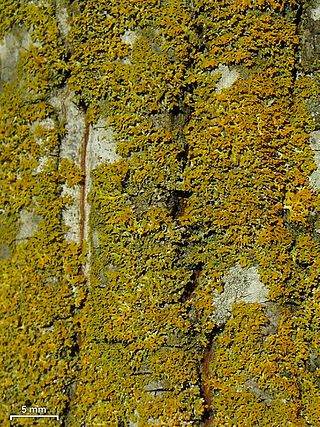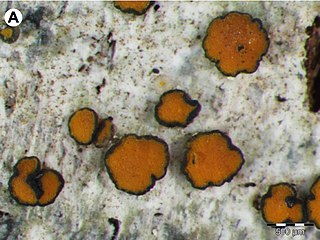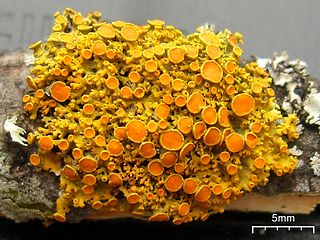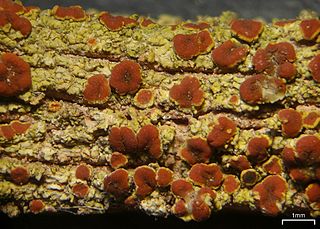
The Teloschistaceae are a large family of mostly lichen-forming fungi belonging to the class Lecanoromycetes in the division Ascomycota. The family has a cosmopolitan distribution, although members occur predominantly in subtropical and temperate regions. Most members are lichens that either live on rock or on bark, but about 40 species are lichenicolous – meaning they are non-lichenised fungi that live on other lichens. Many members of the Teloschistaceae are readily identifiable by their vibrant orange to yellow hue, a result of their frequent anthraquinone content. The presence of these anthraquinone pigments, which confer protection from ultraviolet light, enabled this group to expand from shaded forest habitats to harsher environmental conditions of sunny and arid ecosystems during the Late Cretaceous.

Rusavskia elegans, commonly known as the elegant sunburst lichen, is a lichenized species of fungus in the genus Rusavskia, family Teloschistaceae. Recognized by its bright orange or red pigmentation, this species grows on rocks, often near bird or rodent perches. It has a circumpolar and alpine distribution. It was one of the first lichens to be used for the rock-face dating method known as lichenometry.
Jan Eric Ingvar Kärnefelt is a Swedish lichenologist.

Gallowayella is a genus of lichen-forming fungi in the family Teloschistaceae. It has 15 species. The genus was circumscribed in 2012 by Sergey Kondratyuk, Natalya Fedorenko, Soili Stenroos, Ingvar Kärnefelt, Jack Elix, and Arne Thell, with Gallowayella coppinsii assigned as the type species. The generic name honours New Zealand lichenologist David John Galloway (1942–2014).

Ikaeria is a genus of two species of crustose lichens in the family Teloschistaceae. Both species grow on twig bark of shrubs and trees. It was circumscribed in 2017 by lichenologists Sergey Kondratyuk, Dalip Kumar Upreti, and Jae-Seoun Hur, with Ikaeria aurantiellina assigned as the type species. This lichen was previously placed in the genus Caloplaca, but molecular phylogenetic analysis showed that it belonged in a lineage that was genetically distinct from that genus. Ikaeria serusiauxii was added to the genus in 2020.

Squamulea is a genus of lichen-forming fungi in the family Teloschistaceae. It has 15 species. The genus was circumscribed in 2013 by Ulf Arup, Ulrik Søchting, and Patrik Frödén, with Squamulea subsoluta assigned as the type species. Five species were included in the original account of the genus. The genus name alludes to the squamulose growth form of most of its species. Squamulea has a worldwide distribution; when the genus was originally created, the centre of distribution was thought to be in southwestern North America.
Sirenophila is a genus of crustose lichens in the subfamily Teloschistoideae of the family Teloschistaceae. It has four species with an Australasian distribution.
Alfred Mycolayovych Oxner was a Ukrainian botanist and lichenologist. His research covered various areas: floristics, taxonomy, phylogenetics, phytogeography, and phytosociology. Oxner founded the National Lichenological Herbarium of Ukraine.
Neobrownliella is a genus of crustose lichens in the subfamily Teloschistoideae of the family Teloschistaceae. It has five species. The genus was circumscribed in 2015 by lichenologists Sergey Kondratyuk, Jack Elix, Ingvar Kärnefelt, and Arne Thell, with Neobrownliella brownlieae assigned as the type species. It is a segregate of the large genus Caloplaca. Characteristics of Neobrownliella include a thallus that is continuous or areolate, the presence of anthraquinones as lichen products, a cortical layer with a palisade paraplectenchyma, and the lack of a thick palisade cortical layer on the underside of the thalline exciple. Two species were included in the original circumscription of the genus; an additional three species were added in 2020.

Gallowayella hasseana, the poplar sunburst lichen, is a species of corticolous (bark-dwelling), crustose lichen in the family Teloschistaceae. It occurs in North America.
Rusavskia indica is a species of both corticolous (bark-dwelling) and saxicolous (rock-dwelling) lichen in the family Teloschistaceae. Found in India, it was formally described as a new species in 2017 by lichenologists Sergey Kondratyuk and Dalip Kumar Upreti. The type specimens were collected in Jammu-Kashmir.

Opeltia is a genus of lichen-forming fungi in the family Teloschistaceae. It has four species of corticolous (bark-dwelling), crustose lichens.

Martinjahnsia is a single-species fungal genus in the family Teloschistaceae. It contains the sole species Martinjahnsia resendei, a saxicolous (rock-dwelling) crustose lichen.
Marchantiana is a genus of lichen-forming fungi in the family Teloschistaceae. It contains seven species of corticolous (bark-dwelling), crustose lichens that occur in the Southern Hemisphere.
Orientophila is a genus of lichen-forming fungi in the family Teloschistaceae. It has 15 species of mostly saxicolous (rock-dwelling), crustose lichens. All Orientophila species occur in Northeast Asia including China, Japan, South Korea, and the Russian Far East.
Elixjohnia bermaguiana is a species of saxicolous (rock-dwelling), crustose lichen in the family Teloschistaceae. It is found in Australia. The lichen is characterised by its varying areoles, which are thin to moderately thick, flat to slightly convex, and range from bright yellow to whitish in colour, sometimes with a greenish-yellow hue. Its apothecia are small, with a distinct orange margin and a raised brownish-orange or yellowish-brown disc.
Elixjohnia gallowayi is a species of saxicolous (rock-dwelling), crustose lichen in the family Teloschistaceae. It has a vividly coloured thallus, ranging in hues from bright red to reddish-orange. It is found in Australia.
Oxneriopsis is a genus of lichen-forming fungi in the family Teloschistaceae. It has four species of corticolous (bark-dwelling), crustose lichens.
Elixjohnia jackelixii is a species of saxicolous (rock-dwelling), crustose lichen in the family Teloschistaceae. It is found in Australia and New Zealand. The lichen is characterised by its unique multilayered appearance with outer sterile rings that are brownish or greenish-yellow and inner areoles that are whitish, yellowish, or greyish, often cracked to reveal the medulla underneath. Its fruiting bodies, or apothecia, are typically attached directly to the thallus and vary in colour and shape.









